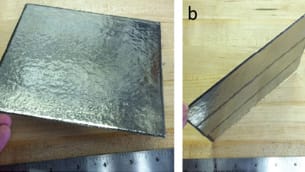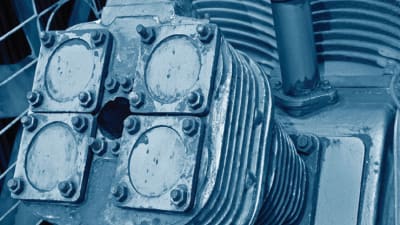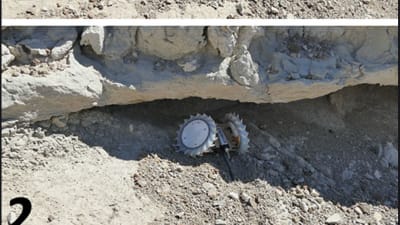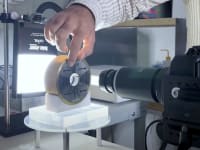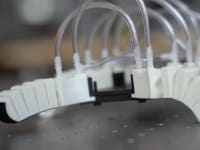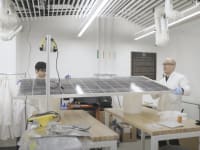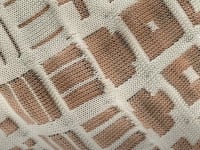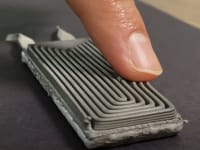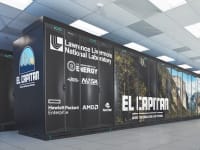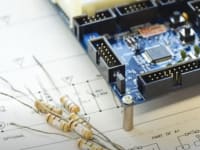61
169
-1
3210
30
Briefs: Robotics, Automation & Control
Researchers developed a wearable robotic system for minimally invasive surgery (also known as keyhole surgery) that will offer surgeons natural and dexterous movement, as well as the...
Briefs: Robotics, Automation & Control
Multi-robot systems deployed in real-world applications are exposed to the same issues that computer systems face. A cybersecurity attack on a robot has the consequences of an attack on a...
Briefs: Software
AUTONOMIE Automotive System Design Software
AUTONOMIE is a MATLAB-based software environment and framework for automotive control system design, simulation, and analysis. It simulates subsystems, systems, or an entire vehicle, and predicts and analyzes fuel efficiency and performance. The software performs analyses and tests for virtual...
Briefs: Software
Numerical Method to Predict the Evaporation Time of a Water Droplet Attached to a Solid Boundary in the Presence of Fluid Flow
One of the objectives of the In-Situ Resource Utilization (ISRU) RESOLVE project was to extract water from lunar regolith by heating and then capturing and quantifying the released water. A potentially large error in...
Briefs: Manufacturing & Prototyping
Functionalization of Carbon Nanotubes
Carbon nanotubes (CNTs) have attracted much attention due to their extraordinary mechanical and unique electronic properties. CNTs are being studied for applications in high-strength/low-weight composites and other applications. In order to alter the CNT properties for particular applications, chemical...
Briefs: Manufacturing & Prototyping
Carbon fiber (CF) and carbon fiber composites have gained widespread use in recent years due to their unique combination of high strength and stiffness-to-weight...
Briefs: Photonics/Optics
Development of a Sodium LiDAR for Spaceborne Missions
Laser and electro-optic technologies are under development to remotely measure sodium (Na) by adapting existing LiDAR technology with spaceflight heritage. The developed instrumentation will serve as the core for planning a heliophysics mission targeted to study the composition and dynamics of...
Briefs: Materials
An alternate heat shield concept for the Orion space vehicle is to use interlocking blocks of Phenolic Impregnated Carbon Ablator (PICA). The blocks are independent from one...
Briefs: Materials
NASA's Langley Research Center has developed a method for producing multifunctional, structural, thermally stable...
Briefs: Mechanical & Fluid Systems
To measure organics in a fluid sample, one either has to bring the sample in the form of a colloid to the instrument, or extract the organics from the sample and bring the...
Briefs: Software
Generation of Cut- and Split-Cells for Face-Piercing Geometry in Embedded-Boundary Cartesian Methods
This innovation addresses several critical issues in the construction of cut control volumes using embedded-boundary Cartesian mesh generators. The innovation considers the case of a surface triangulation intersecting the face of a Cartesian hex...
Briefs: Photonics/Optics
Invertible Time Invariant Linear Filtering (InTILF) Method for Pattern Detection and Modeling of Stochastic One- or Two-Dimensional Data
X-ray astronomy offers the opportunity to observe important phenomena, including the early accretion of massive black holes and detecting diffuse ionized intergalactic gas that is heated to X-ray temperatures...
Briefs: Software
Particle flow fields of high particle concentration are found in many commercial applications, including chemical processing, energy conversion, pharmaceutical processing, food processing, and biomedical...
Briefs: Materials
At high temperatures, currently available cast stainless steel alloys used for engine component applications do not have the long-term stability of their original castings, and are lacking in their ability...
Briefs: Mechanical & Fluid Systems
Advanced Tool Drive System (ATDS) Camera Positioning Mechanism (CPM)
Robotic servicing of a satellite in low earth orbit (LEO) or geosynchronous Earth orbit (GEO) requires advanced systems capable of meeting the harsh environments of space. To support this effort, the Goddard Space Flight Center Satellite Servicing Capabilities Office (SSCO) has...
Briefs: Mechanical & Fluid Systems
Compact, Lightweight Trap Vent
This compact, lightweight trap vent is used to minimize the pressure differential of a high-altitude, balloon-borne detector. The vent allows the pressure to equalize rapidly, yet does not allow any light to enter the detector.
Briefs: Robotics, Automation & Control
There are instances when items (e.g., supplies) need to be lowered from an aerial vehicle to the ground. For example, the United States military often lowers supplies from a rotary winged aircraft...
Briefs: Robotics, Automation & Control
Researchers at NASA's Jet Propulsion Laboratory (JPL) were inspired by origami when they developed the Pop-Up Flat Folding Explorer Robot (PUFFER). Its lightweight design — which can hitch a ride...
Briefs: Robotics, Automation & Control
The traditional interface for remotely operating robots works well for roboticists. They use a computer screen and mouse to independently control six degrees of freedom, turning three virtual rings...
Briefs: Robotics, Automation & Control
The ability to selectively adjust levels and flow rates in fluid control systems is a fundamental aspect of dredged material and fluid management, and necessary to numerous farm...
Briefs: Sensors/Data Acquisition
Characterizing Richness of Previously Unmapped Terrain and Estimating its Impact on Navigation Performance using 3D Range Sensors in Flight
Landers to large planetary bodies such as Mars typically use a secondary reconnaissance spacecraft to generate high-fidelity 3D terrain maps that are subsequently used for landing site selection and creating...
Briefs: Communications
GPS Satellite Geometry Analysis Tool (GPSGEM)
The purpose of the GPS Satellite Geometry Analysis Tool (GPSGEM) is to evaluate GPS satellite geometry for a given Earth-fixed location or for a provided trajectory. The tool will generate a listing of all satellites in view, the best satellite combination defined by the most optimum Geometric Dilution...
Briefs: Propulsion
Propellant Distributor for a Thruster
Innovators at NASA's Glenn Research Center have developed several new technological innovations to improve the capability of Hall-effect thrusters, which are used primarily on Earth-orbiting satellites and can also be used for deep-space robotic vehicles. Hall thrusters are susceptible to discharge channel...
Briefs: Materials
Nanotubular Toughening Inclusions
NASA's Langley Research Center has developed an extensive technology portfolio on novel methods for effective dispersion of carbon nanotubes (CNTs) in polymers. The technology portfolio extends from making stable dispersions of CNTs in polymer resins to processes for making composite CNT/polymer films and articles....
Briefs: Sensors/Data Acquisition
NASA's Langley Research Center has developed a Floating Ultrasonic System for improved nondestructive testing. Most ultrasonic scanners require an...
Briefs: Aerospace
Development of Sodium Lidar for Spaceborne Missions
The metal layers at mesospheric altitudes are excellent tracers of neutral atmosphere dynamics, and have been used since the 1960s to study the chemistry and dynamics of the mesosphere. Ablation from meteors is believed to be the chief source of metals such as Na, Mg, K, Fe, and Ca in the middle...
Briefs: Photonics/Optics
Additive-Manufactured, Very Lightweight, Diamond Turned Aspheric Mirror
Industrial-grade, lightweight mirrors used in military and aeronautics have tight specifications brought on by demanding performance parameters. For example, a mirror that is used in an orbiting telescope would have to be extremely lightweight, stiff, and be configured to...
Briefs: Photonics/Optics
Partially Transparent Circular Mask to Suppress Narrowband Laser Light
The evolved Laser Interferometry Space Antenna (eLISA) is the implementation of the original Laser Interferometry Space Antenna (LISA) concept that will be proposed for the European Space Agency's (ESA) L.3 Cosmic Visions opportunity. The eLISA observatory uses lasers to range...
Top Stories
Blog: Manufacturing & Prototyping
2025 Holiday Gift Guide for Engineers: Tech, Tools, and Gadgets
INSIDER: Research Lab
Scientists Create Superconducting Semiconductor Material
Blog: Software
Quiz: Materials
Blog: Aerospace
Tech Briefs Wrapped 2025: Top 10 Technology Stories
Blog: Manufacturing & Prototyping
Webcasts
 Upcoming Webinars: AR/AI
Upcoming Webinars: AR/AI
The Real Impact of AR and AI in the Industrial Equipment Industry
 Upcoming Webinars: Motion Control
Upcoming Webinars: Motion Control
Next-Generation Linear and Rotary Stages: When Ultra Precision...
 Upcoming Webinars: Energy
Upcoming Webinars: Energy
Hydrogen Engines Are Heating Up for Heavy Duty
 Podcasts: Medical
Podcasts: Medical
How Wearables Are Enhancing Smart Drug Delivery
 Podcasts: Power
Podcasts: Power
SAE Automotive Podcast: Solid-State Batteries




